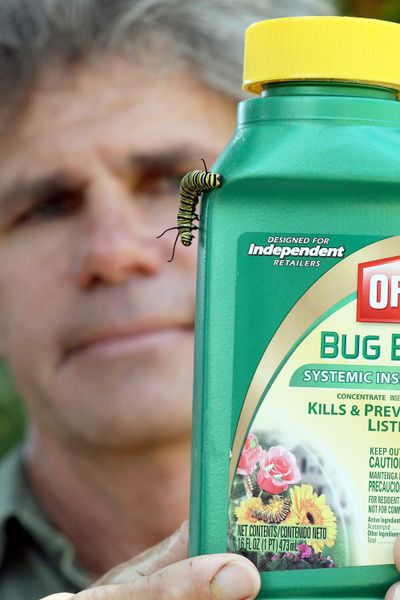Landscaper takes up caterpillar’s cause
Harmless Monarch larva used on Ortho pest-control labels

LOS ANGELES – As quests go, the one Thousand Oaks, Calif., garden designer David Snow embarked on is a doozy.
For six months, Snow has devoted himself to saving the reputation of America’s most beloved butterfly by getting the world’s largest maker of pesticides to change its ways.
Specifically, Snow wants Ortho to change the labels on its “Bug-B-Gon” and “Flower, Fruit and Vegetable Insect Killer” so they no longer feature images of the striking monarch butterfly caterpillar under the ominous vow, “Guaranteed results.”
“This campaign isn’t intended to bring peace to the world, heal the sick, end poverty or bring down Ortho,” Snow said. “All I really want to do is right a wrong.”
Snow noticed the labels last winter and called the consumer complaint center at the company’s Ohio headquarters in February. As he recalls, he said: “I’m sure I’m not the first person to call about this, but why’d you put a good-guy bug on your insect killer? It’s like putting an innocent child’s picture on a U.S. Post Office ‘Most Wanted’ list.”
The response: “Can I have the bar code of the product you’re calling about, please?”
Snow, 52, hung up, but he was only getting started.
In the months since, he has become a chronic pest for Ortho and its parent firm, the Scotts Co. LLC, filing formal complaints and urging others to do so on behalf of monarchs, whose numbers are rapidly dwindling. California’s monarch population has fallen an estimated 80 percent over the last 15 years due to urbanization, drought, weed abatement programs and pesticides, said Scott Black, executive director of the nonprofit Xerces Society, a Portland, Ore.-based organization dedicated to conservation of invertebrates.
The caterpillars are about 2 3/4 inches long, with a pair of black antennae-like appendages at either end of a body ringed with black, yellow and white stripes. They spend most of their three weeks of existence munching on milkweed leaves – the only plant upon which the caterpillars feed, a fact that renders them harmless to home gardeners.
Three weeks ago, with Ortho showing no signs it would change the labels, Snow took his campaign up a notch, posting a petition on the website change.org urging people to “force Ortho to acknowledge their mistake.”
As of Monday however, the petition had attracted a modest 239 signatures.
The Los Angeles Times called Ortho for comment last week. Kokouvi Danklou, supervisor of the company’s call center, gave the Times a measured response. “Everything about this case has been forwarded to our marketing team,” Danklou said. But he added: “We consider this a very, very serious matter.”
Last Friday, Lance Latham, a spokesman for the Scotts Miracle-Gro Co., called the Times to say: “We’re updating that label to ensure there is no confusion with the monarch butterfly caterpillars. Consumer concerns are something we always look into.”
A few minutes later, a company official left a cheery message on Snow’s business phone.
“Hi there, David,” the official said. “I just want to let you know I followed up on your calls, and we’re changing the labels. Thanks for letting us know about your concerns.”
Score one for the butterfly.